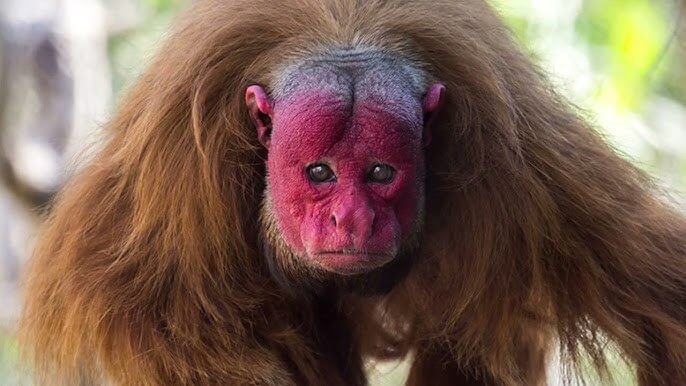
Imagine sipping coffee with a friend who just heard about uakaris for the first time. You’d probably share stories about how these monkeys live, their social behaviors, and the way they solve problems in the wild. It’s kind of like discussing a new favorite band—everyone loves learning the quirky details. So, let’s break down the cognitive abilities of the uakari and see just how smart these little guys really are.
What Makes Uakaris Unique?
Uakaris are easily recognizable due to their distinctive appearance. They have short, hairless faces and are often covered in thick, fluffy fur. But their looks are just part of their charm; uakaris are also known for their interesting social behaviors. They live in groups, which helps them learn from one another. When one monkey discovers a new food source or a potential threat, others in the group often learn from that experience.
These monkeys are primarily found near riverbanks in the Amazon, where they navigate through the trees in search of fruits, seeds, and insects. Their habitat—lush and complex—encourages the development of their skills. Just think about it: living in such a rich environment means they have to be pretty clever to find food and avoid predators.
Social Intelligence of Uakaris
In the animal kingdom, social intelligence can be just as essential as problem-solving skills. For uakaris, life in a group means developing strong social bonds. They communicate using a range of vocalizations, facial expressions, and body language. Each monkey knows its place within the group and often engages in grooming, which helps strengthen these social ties.
You might be wondering how this ties back to their intelligence. Well, social interaction requires a level of understanding and empathy. Uakaris can recognize individual members of their troop, understand social hierarchies, and respond appropriately to the emotions of others. This group dynamic not only keeps the troop safe but also enhances their overall learning capabilities.
Problem-Solving Skills
When looking at the cognitive abilities of uakaris, one big aspect to consider is their problem-solving skills. In the wild, these monkeys often face challenges, from finding food to evading predators. Research shows that they can use tools, like sticks, to extract insects from crevices. This behavior highlights not just their intelligence but also their capacity to innovate and adapt.
Here’s an interesting thought: if you were trying to reach a tasty treat, wouldn’t you try various methods to get it? Uakaris do the same! They experiment with different approaches, sometimes watching others to learn the best technique. This kind of trial and error is a clear indicator of cognitive ability.
Memory and Learning
Memory plays a crucial role in how uakaris survive in their environments. These monkeys must remember where to find food and which areas to avoid due to predators. Studies suggest that they have a well-developed spatial memory, allowing them to navigate their complex habitats effectively.
Let’s put this into perspective. Imagine you were in a huge, unfamiliar city. The ability to remember landmarks and routes is essential for finding your way around. Uakaris possess similar skills, which helps them thrive in their vast, dynamic environment. Their memory isn’t just useful for daily survival; it’s also a key element in social interactions. Remembering past encounters with other monkeys can help them manage relationships effectively.
Comparing Uakaris to Other Primates
When discussing how intelligent uakaris are, it’s helpful to compare them to other primates. While they’re not as famously clever as chimpanzees or orangutans, they hold their own in the primate world. For instance, chimpanzees are known for their advanced tool use and problem-solving, but uakaris excel in their social intelligence and adaptability.
This doesn’t mean uakaris are less smart; they just have different strengths. While some primates might focus on individual problem-solving, uakaris thrive in group settings, showcasing their intelligence through social skills. In essence, each species brings something unique to the table, and uakaris exemplify social intelligence in a very engaging way.
The Importance of Conservation
Understanding uakaris and their cognitive abilities sheds light on the importance of conserving their habitats. As deforestation and climate change threaten the Amazon rainforest, we risk losing not only these unique monkeys but also the entire ecosystem that supports them. Protecting their habitat ensures that they can continue to exhibit their fascinating behaviors and skills.
If we look at uakaris as a symbol of a thriving ecosystem, it’s clear that their preservation is critical. Supporting conservation efforts helps maintain biodiversity and allows future generations to appreciate these remarkable creatures. It’s a reminder that every species, no matter how small, plays a role in the larger story of our planet.
In wrapping up, the uakari is more than just a pretty face; they are intelligent creatures with impressive cognitive abilities. From their problem-solving skills and social interactions to their memory and adaptability, these monkeys show us that intelligence is multifaceted. Whether they’re using tools to find food or forging bonds within their troops, uakaris remind us of the wonder of nature.
So, the next time you hear about uakaris, remember that these monkeys are not only cute but also incredibly smart in their own right. Their behaviors and skills highlight the importance of understanding and conserving the natural world around us. It’s all connected, and every little bit matters.
